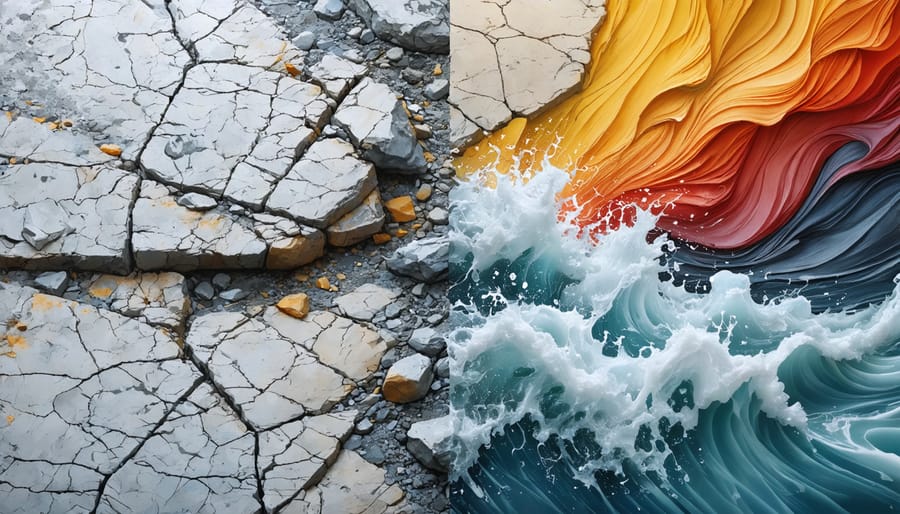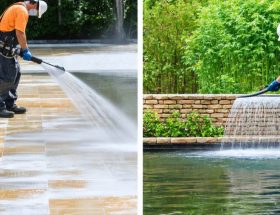Weathering and erosion wage a constant battle against stone surfaces, yet understanding their distinct mechanisms empowers property owners to protect their investments effectively. While weathering breaks down materials through chemical and physical processes like freeze-thaw cycles and acid rain, erosion actively transports these degraded particles away through wind, water, and mechanical forces. Implementing modern stone conservation techniques can significantly extend the life of stone features by addressing both processes simultaneously.
Natural stone’s vulnerability to these forces demands proactive protection, particularly in exposed architectural elements like facades, fountains, and outdoor sculptures. The interplay between weathering and erosion accelerates deterioration – as weathering weakens stone’s structural integrity, erosion strips away the compromised surface layers, exposing fresh material to further attack. This cycle, left unchecked, can transform pristine stone features into deteriorated shadows of their former beauty within decades.
Understanding these distinct yet interconnected processes enables property owners and architects to develop targeted preservation strategies that address both immediate surface protection and long-term structural integrity.
The Science Behind Stone Deterioration
Weathering: The Chemical and Physical Breakdown
Weathering is a complex process that gradually transforms stone through both chemical and physical mechanisms. Unlike erosion, which involves material transportation, weathering occurs in place, slowly altering the stone’s composition and structure through environmental exposure.
Chemical weathering primarily involves reactions between stone minerals and environmental elements. Water, particularly when acidic due to pollution or natural factors, can dissolve certain mineral components. This process, known as dissolution, often creates pitting and etching on stone surfaces. Oxidation, another common chemical reaction, occurs when minerals interact with oxygen, often resulting in color changes and surface deterioration.
Physical weathering, also called mechanical weathering, breaks down stone without changing its chemical composition. Freeze-thaw cycles are particularly damaging, as water expands upon freezing within stone pores, creating internal pressure that can cause cracking. Temperature fluctuations lead to thermal stress, causing stone to expand and contract repeatedly, weakening its structure over time.
The impact of weathering varies significantly based on stone type and environmental conditions. Softer stones like limestone are particularly vulnerable to chemical weathering, while harder materials like granite better resist these effects. However, all stone types benefit from proper maintenance and sustainable stone restoration practices to minimize weathering damage.
Understanding these weathering processes is crucial for predicting how stone will perform in different environments and determining appropriate preservation measures. Regular monitoring and maintenance can help identify early signs of weathering before significant damage occurs.
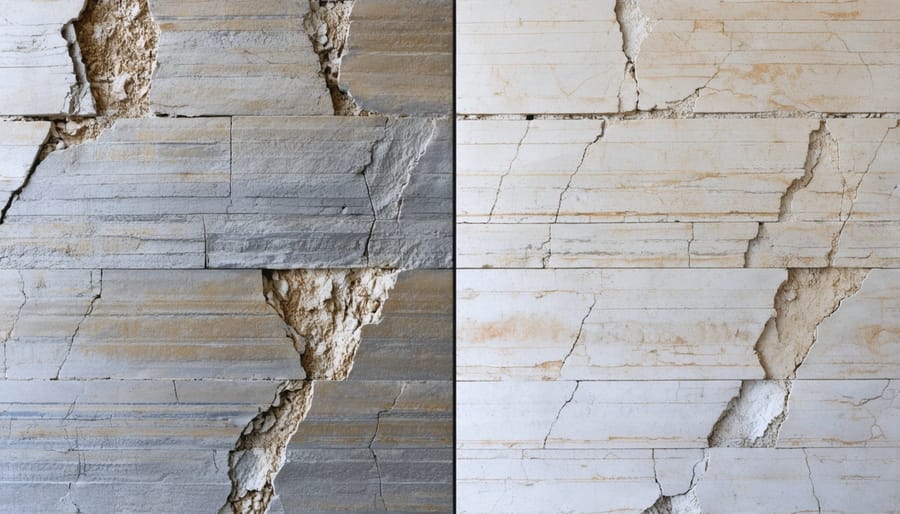
Erosion: The Transport of Weathered Material
While weathering breaks down stone materials, erosion is the process that moves these weathered particles from one location to another. This transport can occur through various natural agents, each leaving distinctive marks on stone surfaces.
Water is perhaps the most significant erosional force, carrying particles away through rainfall, rivers, and ocean waves. In urban environments, repeated water flow from downspouts or improper drainage can create channels in stone facades and pavements. Wind erosion, particularly significant in exposed locations, can blast stone surfaces with airborne particles, gradually wearing away softer portions of the stone and creating pitted surfaces.
Gravity plays a crucial role in erosional processes, especially on sloped surfaces where loosened material naturally moves downward. This can be particularly concerning for stone retaining walls or facades where weathered material may gradually migrate downward, potentially compromising structural integrity.
The impact of erosion on stone surfaces varies depending on the stone type and environmental conditions. Softer stones like limestone and sandstone are particularly vulnerable to erosional forces, while harder materials like granite show greater resistance. Common signs of erosion include:
– Channeling or gullies in stone surfaces
– Smoothed or rounded edges
– Accumulation of stone particles at the base of structures
– Uneven wear patterns
– Loss of surface detail or carved features
Understanding erosion patterns is crucial for maintaining stone installations and implementing appropriate preventive measures. Regular inspection of drainage systems, proper water management, and the installation of protective features can significantly reduce erosional damage to stone surfaces.
Common Weathering Patterns in Natural Stone
Chemical Weathering Signs
Chemical weathering leaves distinct patterns that can help identify its presence and underlying causes. The most common signs include surface etching, where acidic rain or pollutants create small depressions in the stone. These patterns often appear as irregular pitting or honeycomb-like textures, particularly visible on limestone and marble surfaces.
Discoloration is another telltale indicator, manifesting as rust-colored staining on stones containing iron minerals or green patina on copper-bearing stones. When examining surfaces, look for powdery residues or mineral deposits, which often indicate ongoing chemical reactions between the stone and environmental elements.
Stone professionals specializing in protecting historic stone surfaces frequently encounter efflorescence, appearing as white crystalline deposits on stone surfaces. This occurs when soluble salts within the stone migrate to the surface and crystallize, potentially indicating moisture problems or chemical reactions with cleaning products.
Exfoliation, where stone layers peel away like onion skin, can result from chemical weathering combined with temperature fluctuations. Pay particular attention to areas near industrial zones or coastal regions, where air pollution and salt spray accelerate chemical weathering processes. Understanding these signs helps in early detection and appropriate intervention to prevent further deterioration.
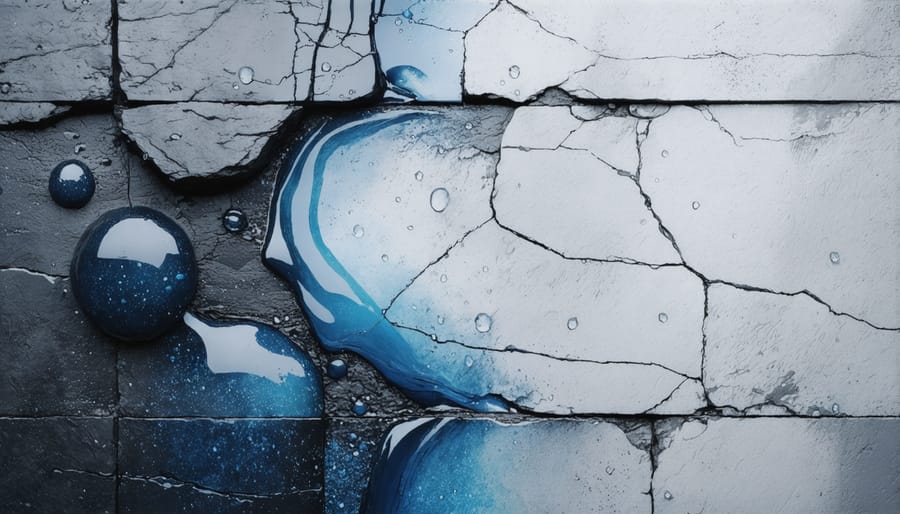
Physical Weathering Indicators
Physical weathering in natural stone reveals itself through distinct visual and tactile indicators that develop over time. The most common signs include surface roughening, where once-smooth stone becomes increasingly textured, and the formation of small cracks or fissures along natural bedding planes. These cracks often start as hairline fractures and gradually widen due to freeze-thaw cycles or thermal stress.
Color changes frequently accompany physical weathering, with stones showing patchy discoloration or lightening, particularly in areas exposed to direct sunlight or heavy rainfall. The edges and corners of stone blocks or features typically display rounding or softening, losing their crisp, defined appearance. This pattern is especially noticeable in architectural elements like cornices and window sills.
Exfoliation, where thin layers of stone peel away like onion skin, indicates advanced physical weathering, commonly seen in granite and sandstone. Surface pitting, characterized by small depressions across the stone face, develops when minerals weather at different rates, creating an uneven texture.
Granular disintegration, where individual mineral grains become loose and fall away, results in a sandy or gritty texture when touched. This condition is particularly common in sandstone and some varieties of granite. Understanding these indicators helps property owners and professionals identify weathering patterns early, enabling timely intervention before significant damage occurs.
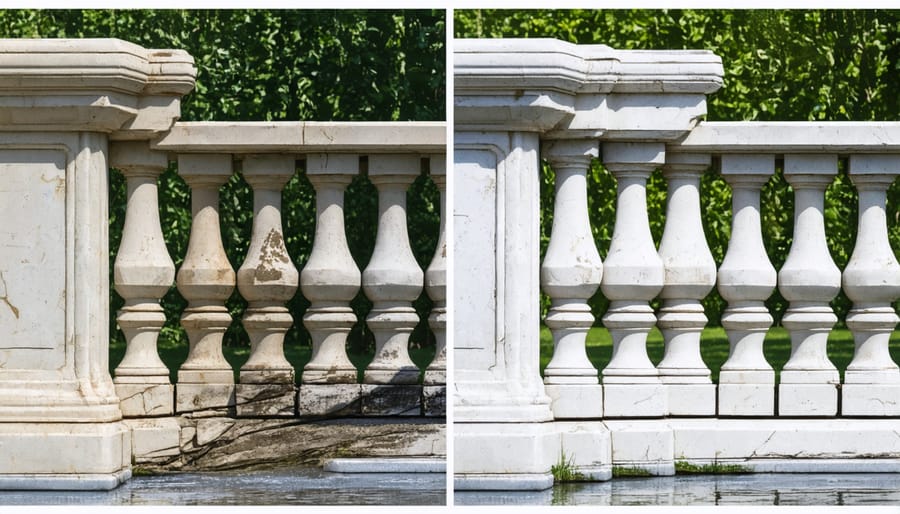
Protecting Your Stone: Prevention Strategies
Protecting your stone from weathering and erosion requires a proactive approach and regular maintenance. By implementing effective stone preservation methods, you can significantly extend the life and beauty of your stone surfaces.
Start by applying appropriate sealants specifically designed for your stone type. For exterior applications, use penetrating sealers that allow the stone to breathe while providing protection against moisture infiltration. Reapply sealants according to manufacturer recommendations, typically every 2-5 years depending on exposure levels.
Proper drainage is crucial for preventing water damage. Install adequate gutters and downspouts to direct water away from stone surfaces. For ground-level installations, ensure a slight grade that allows water to flow away from the stone. Consider installing drip edges or water breaks to prevent water from constantly running down vertical stone surfaces.
Regular cleaning helps prevent the accumulation of harmful substances. Use pH-neutral cleaners specifically formulated for natural stone, and avoid acidic or abrasive cleaning products that can accelerate weathering. Remove organic matter, such as leaves and debris, promptly to prevent staining and moisture retention.
For vulnerable areas, consider installing physical barriers or protective coverings during severe weather conditions. This might include temporary awnings during rainy seasons or protective screens against wind-driven particles in areas prone to sandstorms.
Monitor your stone regularly for signs of damage or wear. Address any issues promptly – small problems can quickly escalate if left untreated. Pay special attention to joints and sealants, replacing them as needed to maintain water-tight barriers.
In freeze-thaw environments, ensure proper insulation and heating systems are in place to prevent frost damage. Consider applying anti-freeze treatments to particularly vulnerable stone surfaces during winter months.
Professional maintenance inspections every 1-2 years can help identify potential issues before they become serious problems. These inspections should include assessment of structural integrity, sealant effectiveness, and overall condition of the stone.
Understanding the distinction between weathering and erosion is crucial for maintaining natural stone’s beauty and durability. While weathering gradually alters stone through chemical and physical processes, erosion actively removes material through environmental forces. Both processes can significantly impact stone surfaces, but with proper maintenance and preventive measures, you can protect your stone investments effectively. Regular inspections, appropriate sealing treatments, and prompt attention to signs of deterioration will help preserve stone surfaces. Remember that different stone types require specific care approaches, and consulting with stone care professionals can ensure you implement the most effective protection strategies for your particular application. By staying proactive in stone maintenance, you can significantly extend the life and appearance of your stone surfaces while protecting their value and functionality.

